

Case Study:
Mt. Everest

Case Study:
Marine Exploration

Case Study/Video:
Red Bull Racing

Case Study:
Tablet PC at Beer Wholesaler

Tablet PC
Torture Chamber

|

|

|
|
MobileDemand xTablet T7200 Tablet PC
The latest generation of MobileDemand's compact rugged tablet computer tougher and faster than ever, and now offers an innovative indoor/outdoor display option
(by Conrad H. Blickenstorfer
)
Almost three years ago, before anyone even knew of the iPad, MobileDemand of Cedar Rapids, Iowa, had a new idea. They made a smaller, lighter tablet instead of a bigger one. It only had a 7-inch screen and we wondered if that might perhaps be too small for serious work. Turns out it wasn't too small, and MobileDemand's little xTablet T7000 became their biggest seller ever, by a good margin.
It is three years later, the iPad rules the world, and everyone is tapping, panning, pinching and zooming on their capacitive multi-touch tablets and smartphones. So when MobileDemand called and said they'd introduce a new tablet we wondered if it might be a ruggedized iPad class device. Nope. It's still the tough little 7-inch tablet that works so well for them and their customers. But the new one is much, much faster. And it has some new tricks up its sleeves. Read on.

Let's start by explaining what the xTablet T7200 is, and what it isn't. What it is is a fanless 3/4-scale version of what the industry considered a full-size tablet for many years, one that weighs barely more than half as much as those older standard-size tablets. What it is not is a boxy, rugged version of a iPad-style media tablet. For that, the xTablet T72000 would have to have a capacitive touch screen, a sleeker profile, and bet its appeal and success on the upcoming Windows 8. It's not. The new xTablet T7200 is unapologetically what it has always been: a Tablet PC to run classic Windows software on.
Given that Microsoft is almost betting the farm on touch and looking more like Apple, is this a bad thing or a good thing? At this point, no one knows. Hundreds of millions of smartphones now run the Android OS, but almost all industrial and vertical market handhelds still run an older version of Windows Mobile. In consumer tablets, almost three years after the iPad's introduction, Android is only now slowly getting traction, and most of the traditional vertical tablet makers have stayed with Windows, for better or worse.
Why is that? Probably because even in 2012, well over 80% of all personal computers worldwide still run one version or Windows or another. So whether it's pretty or fashionable or not, Windows remains the industry OS default until further notice, and that means that there are many, many applications that require a tablet but still must work with Windows. So there. That's the business case, pure and simple. And it's one that has worked very well for MobileDemand. They keep getting mentioned as being among the fastest growing businesses in their market.
But now let's see what all is new and exciting with this next version of MobileDemand's compact tablet:
The xTablet T7x00 platform
While both consumer media tablets and vertical/industrial market tablets are called tablets, there is a big difference between the two. While the former are as thin and sleek as possible, the latter emphasize durability, toughness, expandability, versatility and functionality. That makes them heavier and boxier.
As those who have used both an iPad and a 7-inch consumer tablet well know, smaller size in tablets usually means some compromises, but compared to larger tablets, the xTablet T7200 keeps those at a minimum. The compilation picture below shows the tablet from the front and all four sides. As you can see, the design is packed with features and makes excellent use of the available space.

The 7-inch wide-format display leaves room for an integrated physical keypad that can speed up data entry tremendously. Directional and function keys, likewise, add to efficient operation.
On the right side is a fabric loop that holds the tablet's 5-1/2-inch passive stylus. Beneath it are two I/O blocks, one with a single RS232 DB9 serial port, the other with an RJ45 LAN port and a USB 2.0 interface. The three ports are actually on a single I/O board inside the unit, and MobileDemand can easily make different I/O configurations available. Both ports are protected with thin, flexible rubber flaps that are a bit hard to open and reseat.
On the left side there is the power jack and a Kensington lock slot. On the picture you can also see the two D-rings for the carry strap. The loops can be attached to any of the four sides of the device.
On the bottom is the surface-mount docking connector. There are also two screw holes for securing the unit to docks.
 On top of the unit is an expansion slot opening with a SD Card slot and either a PC Card slot, a mini-PCIe slot or a Smart Card reader. Our unit had a mini-PCIe based mobile broadband radio. The bump contains the WWAN module's antenna. To the left of it, under a cover, sits the u-Blox GPS module. To the right is the xTablet T7200's Intermec 1D/2D CMOS imager (EA11 in our unit; see here). On top of the unit is an expansion slot opening with a SD Card slot and either a PC Card slot, a mini-PCIe slot or a Smart Card reader. Our unit had a mini-PCIe based mobile broadband radio. The bump contains the WWAN module's antenna. To the left of it, under a cover, sits the u-Blox GPS module. To the right is the xTablet T7200's Intermec 1D/2D CMOS imager (EA11 in our unit; see here).
The xTablet T7200 has an integrated digital camera. It is directed away from the user, with its lens mounted centrally on the backside of the unit (you can see it in the picture above). The availability of a camera will come in handy for documentation tasks, and systems integrators will probably include its functionality into customs applications.
All four corners of the xTablet T7200 are protected by thick and very sturdy rubber bumpers. They are fastened to the unit with four small Phillips head screws each, making them easily replaceable. Rubber bumpers add a bit of size to a device, but they are an excellent low-tech way to provide extra protection.
The xTablet T7200 feels exceptionally solid. There is no give or twisting. We did not disassemble our preview unit to examine the guts and magnesium chassis. The housing is a tough black plastic. The finish is black matte.
Intel Atom N2600 -- third gen of Intel's netbook processor family
The xTablet T7200 is powered by either a 1.6GHz Intel Atom N2600 or a 1.86GHz Intel Atom N2800 processor, and this warrants some discussion. Intel's Atom processors were conceived a few years ago as a simpler, less expensive alternative to Intel's increasingly complex and costly Core processors. Somewhat confusingly split into two different processor families (initially "Silverthorne" for mobile internet devices, and "Diamondville" for low-cost notebooks), Intel scored an unexpected hit when inexpensive Intel Atom-powered netbooks took off and sold by the tens of millions.
The N2600 processor used in this MobileDemand Tablet PC is a third generation descendent (codenamed "Cedarview") of those initial netbook CPUs rather than a successor to the Z530 "Silverthorne" chip used in the T7000. The N2600/N2800 were introduced in late 2011 and arrived at a time when netbooks had become all but replaced by tablets, most of which are powered by ARM processors. Windows 7, however, does not run on ARM processors, and so the Windows-based media tablets currently available run on Atom chips. rather than a successor to the Z530 "Silverthorne" chip used in the T7000. The N2600/N2800 were introduced in late 2011 and arrived at a time when netbooks had become all but replaced by tablets, most of which are powered by ARM processors. Windows 7, however, does not run on ARM processors, and so the Windows-based media tablets currently available run on Atom chips.
Atom's predicament was always that the chips had to be inexpensive enough to make possible economically priced computing devices, but without being powerful enough to eat into the lucrative Core processor market. The initial Atoms offered surprising speed in netbooks even with Windows 7, but graphics performance was lacking and video playback virtually impossible. Intel addressed the graphics issue somewhat in the second generation "Pineview" netbook processors that had an integrated graphics GPU. In our testing we frankly didn't see much graphics improvement in second-gen Pineview-based systems.
The third generation of, for lack of a better term, "netbook" processors, however, is an entirely different story. It's the first Atom family to use 32nm process technology instead of the older 45nm, making for smaller, more efficient packages. All members of the Cedarview processor family are dual-core systems whereas before only desktop-oriented versions had two cores. Graphics performance benefits from a different design and much faster clock speed, resulting in Intel claims of 2X graphics performance compared to the second generation Atoms. And integrated hardware-accelerated video decoding finally enables smooth full HD (up to 1080p) video playback.
|
PERFORMANCE COMPARISON
|
MobileDemand
|
MobileDemand
|
|
|
Model
|
xTablet T7200
|
xTablet T7000
|
|
OS
|
Win 7 (32-bit)
|
Win 7 (32-bit)
|
|
Processor Type
|
Intel Atom
|
Intel Atom
|
|
Processor Model
|
N2600
|
Z530
|
|
CPU Speed
|
1.60Hz
|
1.60Hz
|
|
Thermal Design Power (TDP)
|
3.5 watts
|
2.3 watts
|
|
CPU Mark
|
483.9
|
232.7
|
|
2D Graphics Mark
|
77.9
|
74.0
|
|
Memory Mark
|
224.7
|
214.4
|
|
Disk Mark
|
1,706.8
|
333.6
|
|
3D Graphics Mark
|
72.4
|
41.8
|
|
Overall PassMark
|
532.0
|
183.5
|
|
ALU
|
10,680
|
6,319
|
|
FPU
|
7,997
|
3,725
|
|
MEM
|
6,991
|
4,097
|
|
HDD
|
27,116
|
10,324
|
|
GDI
|
855
|
916
|
|
D2D
|
778
|
936
|
|
OGL
|
7,101
|
332
|
|
Overall CrystalMark
|
61,518
|
26,649
|
In essence, the progression was from the limited N270 that was nonetheless capable of powering all those netbooks, to the N450 with integrated graphics, and now to the dual-core N2600 with twice the L2 cache, twice the graphics clock speed, and faster DDR3 memory. Processor clock speed never changed from the 1.6GHz range, and the N2600 still uses the Intel NM10 Express chipset already used in the second generation. Thanks to the 32nm process technology and additional power conservation measures, the N2600 has a maximum thermal design power of just 3.5 watts, considerably less than the 5.5 watts of the second-gen N450. The NM10 Express chipset is miserly as well, with a TDP of just 2.1 watts, making for a combined CPU/chipset maximum draw of just 5.6 watts. As a result, Intel's promo materials predicted "up to 10 hours of battery life on portable devices."
To provide an idea of the much greater performance of the Atom N2600-powered xTablet T7200 tablet compared to the Atom Z530-powered predecessor T7000, we ran the new device through our two standard benchmark suites (PassMark and CrystalMark). The results are listed in the table to the left.
In its press release materials, MobileDemand claimed that the xTablet T7200 had 2.35 times the CPU performance and 3.93 times the disk performance of the predecessor T7000. Our own results confirm that assessment.
MobileDemand also says that the new processor platform allows "to handle graphic intensive applications at a lower price than other high-end processors." High-end, of course, is relative. Even the latest Atoms don't come close to second or third gen Intel Core processors, but depending on processor model and device configuration, they can now reach what used to be Core 2 Duo performance territory. And the N2600/N2800 are definitely way quicker than other high-end Atom processors. As for graphics, performance improvements will depend on the type of graphics, but overall graphics speed is greatly improved. Video playback used to be a huge weak spot in earlier Atoms whereas the xTablet T7200 plays back even 1080p HD video at full speed. And those who need OpenGL graphics will find massive improvement in the xTablet T7200 as well.
Not all the praise, however, goes to Intel. There are two reasons for this excellent performance. Yes, the N2600/N2800 chips are much better performers than any of the earlier Atom platforms, but benchmarks are a summary of all of the subsystems that combine for a computer's real-world performance. MobileDemand knows that and has long been an advocate of employing the considerable speed advantage of solid state disks over rotating media. Our (p)review machine came with a 64GB Avant mSATA solid state disk that delivered truly blazing disk performance. Unlike the predecessor model that still came standard with a rotating hard disk, those are gone now and it's all SSD.
Wireless communication
For wireless communication, the MobileDemand xTablet T7200 Tablet PC includes an Intel Centrino Advanced-N 6235 wireless network adapter. This is a half-mini PCIe card that provides dual-band 802.11a/g/n WiFi as well as Bluetooth 4.0, all in one module. This means receive data rates up to 300Mbps in "n" networks (802.11a/b/g maxes out at 54Mbps) and an over 5-time bandwidth increase over 802.11a/b/g. The module is very power-efficient, supports Cisco compatible extensions v4, and Bluetooth 4.0 is backward compatible with earlier versions.
For mobile broadband, the xTablet T7200 can be equipped with either 3G GOBI 3000 for vendor and wireless technology independence, or 4G LTE for Verizon.
On the GPS side, customers can get an optional integrated u-Blox 6 module.
New xView Pro™ display: transmissive and reflective
Tablet PCs like the xTablet T7200 are going to be used in vehicles, outdoors, and sometimes in direct sunlight. This means they must be viewable and readable under a wide variety of lighting conditions. Outdoor-viewable display technology has come a long way in the last few years, generally using a combination of transmissive LCDs (for vibrant indoor viewing), a variety of optical treatments (for maximizing contrast outdoors), and a strong backlight (to boost contrast as much as possible). That works quite well, but even with the best optical treatments, transmissive LCDs rely on the strongest possible backlight in direct sunlight, and that can drain batteries very quickly. So MobileDemand took a different approach with their new xView Pro.
While MobileDemand's standard xView uses the optical treatments/backlight approach described above, xView Pro uses pixels that have both a transmissive and a reflective part, with the two parts controlled separately. Indoors, the screen works pretty much like a regular transmissive display with a backlight. Outdoors, the reflective pixels take over and an ambient light sensor lowers the no longer needed backlight, or turns it off entirely. The switch between the two modes is gradual, so as you walk from inside or shaded areas into brighter light, colors fade, but contrast actually grows as ambient day or sunlight becomes stronger.
There's also some pixel magic. From what I can tell, in transmissive mode, the xTablet T7200's xView Plus display has 1024 x 600 pixel resolution and 256k colors. As ambient light gets stronger, the display enters a transflective mode where it still has 1024 x 600 resolution but combines that with 64 grayscales. The light sensor turns the backlight lower, the reflective subpixels now reflect ambient light, and colors look more muted. In direct sunlight, the light sensor completely turns off the backlight and the display is in fully reflective mode where the actual resolution is now 3072 x 600 pixel because the red, green, and blue parts that make up one pixel in color mode are now used in black and white mode, and become separate pixels with separate driver control. Each pixel has 6-bit adjustment, which means 64 gray scales. When used as color pixels, 64 x 64 x 64 equals 262,144 shades of color, or 256k.
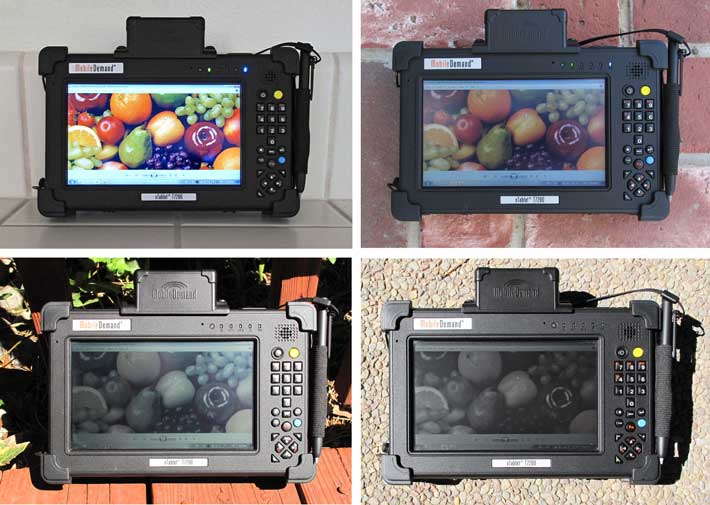
Above you can see what it all looks like in practice. In the the upper left, indoors the xTablet T7200 display looks pretty much like a standard transmissive display. Upper right, in shaded areas outdoors, the color remains, but it's more muted. Lower left: In bright sunlight, but not directly facing the sun, there is a trace of color left, but it's clear that the display is now mostly in reflective mode. Bottom right: in direct, strong sunlight, color is virtually gone and the display is in reflective mode.
The two pictures below again show the display mode switch from reflective in direct sun (left) to transflective in the shade.
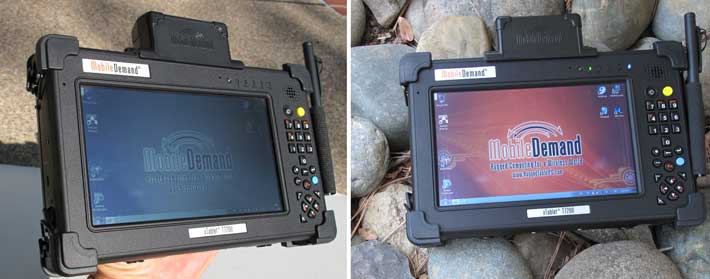
And to show how the xTablet T7200 compares outdoors to a standard consumer tablet, the picture below shows its relative size next to a Google Nexus 7 tablet. The Nexus actually does quite well, but like almost all consumer tablets, its glossy display surface is unable to handle outdoor reflections. The xTablet T7200's display surface is semi-matte and has good reflection and glare control.
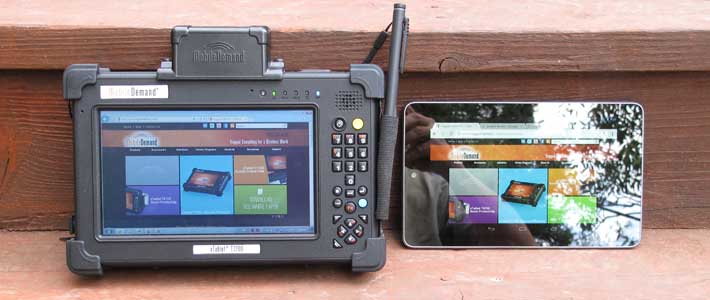
Note that since the backlight goes off in sunlight, another key advantage of xView Pro over conventional displays is significant battery power savings when the xTablet T7200 is used outdoors. MobileDemand is definitely to be congratulated for offering the novel xView Pro display as an option.
Ruggedness and details
MobileDemand has been synonymous with rugged Tablet PCs since the company's start, and the xTablet T7200 is no exception. It's a very solid, very well built computer and can handle a good degree of punishment (as MobileDemand likes to demonstrate in their often hilarious ruggedness testing videos). The operating temperature range remains the same at -4 to 140 degrees Fahrenheit (-20 to 60 degrees Centigrade), but the tablet can now handle repeated drops from five feet per MIL-STD-810G, 516.6 IV, and sealing is now at the IP65 level. That means the xTablet T7200 is totally protected against dust, and it can also handle low pressure water jets from all directions, albeit with limited ingress permitted.
The chassis of the xTablet T7200 is made of lightweight magnesium alloy, the housing of a tough plastic. Everything feels very sturdy, and there is extra protection provided by the rubber bumpers that are screwed onto every corner. All ports are protected by hinged rubber plugs. These must be firmly in place as there are no additional barriers between the outside and inside of the xTablet T7200.
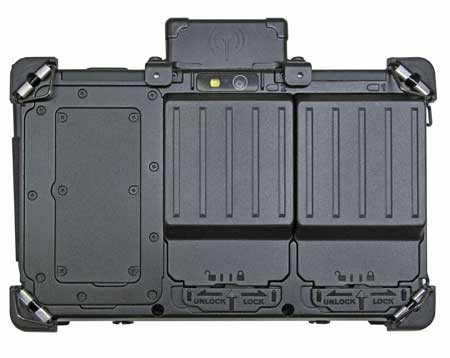 The picture to the right shows the backside of the xTablet T7200. Our review unit had two Lithium-Ion batteries packing 37.5 watt-hours each. They are securely held in place with two pressure-loaded sliders. This way, you can pop in a fresh battery without shutting down the computer since power is provided by the second battery. Mobile Demand rated the predecessor T7000 good for about 3.5 to 4 hours with standard batteries and 7.5 hours with hi-capacity batteries. The xTablet T7200 is supposed to run up to 10 hours with the hi-capacity batteries (that are now standard). Above the left battery you can see the lens of the integrated 5-megapixel camera with its LED illuminator (that's new for the xTablet T7200). The picture to the right shows the backside of the xTablet T7200. Our review unit had two Lithium-Ion batteries packing 37.5 watt-hours each. They are securely held in place with two pressure-loaded sliders. This way, you can pop in a fresh battery without shutting down the computer since power is provided by the second battery. Mobile Demand rated the predecessor T7000 good for about 3.5 to 4 hours with standard batteries and 7.5 hours with hi-capacity batteries. The xTablet T7200 is supposed to run up to 10 hours with the hi-capacity batteries (that are now standard). Above the left battery you can see the lens of the integrated 5-megapixel camera with its LED illuminator (that's new for the xTablet T7200).
MobileDemand pointed out that the hi-capacity batteries now have a lower profile (they protrude about a third of an inch of thickness).
Integrated cameras have traditionally been a weak link in handheld and tablet computers. Which is weird because every modern smartphone now has a superb camera fully capable of shooting 1080p HD video. As is, the 5mp camera of the xTablet T7200 is one of the better ones and can be used for documentation purposes, though it still falls far short of smartphone camera quality.
Numeric keypad and other data entry methods
While tablet computers specifically exclude a keyboard to make them lighter and handier, there's often nothing like a keypad for quick data entry. That's why the xTablet T7200, despite its small size, offers an almost identical keypad to that on MobileDemand's larger T8700 tablet. Below is a closeup view of the xTablet T7200's keypad:

- a standard phone-style keypad
- a navigation diamond
- volume up/down via functions key
- screen brightness up/down in 10 increments via function key
- dedicated plus, minus, period keys
- dedicated tab, backspace, enter keys
- Windows Task Manager key
- blue and yellow key for special functions
- Functions: Esc, wireless on/off, screen rotation, keypad backlight
The numeric keypad is firm and provides very good tactile feedback -- handy for rapid-fire numeric data entry.
 The keypad, of course, is only one way to enter data into the xTablet T7200. You can also use it as an electronic notepad with Microsoft Journal (see screen capture to the right). Depending on your style of work, Journal can be a terrific productivity tool. You can scribble notes in electronic ink, do quick drawings, convert handwritten notes to text, email notes, and so on. There are different pens, highlighters and an eraser. Also very handy is the "Snipping Tool" that allows you to quickly grab any part of the display, annotate it if you wish, and then save it or mail it. The keypad, of course, is only one way to enter data into the xTablet T7200. You can also use it as an electronic notepad with Microsoft Journal (see screen capture to the right). Depending on your style of work, Journal can be a terrific productivity tool. You can scribble notes in electronic ink, do quick drawings, convert handwritten notes to text, email notes, and so on. There are different pens, highlighters and an eraser. Also very handy is the "Snipping Tool" that allows you to quickly grab any part of the display, annotate it if you wish, and then save it or mail it.
Also available are on-screen keyboards and handwriting recognition. The latter requires some getting used to, but once mastered it works almost flawlessly. The recognizer can be used as is, or you can "personalize" it so it learns your handwriting style or how to handle characters or words that are recognized incorrectly.
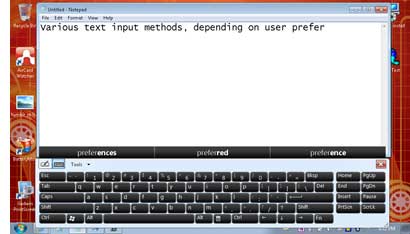 The xTablet T7200 is, in fact, one of the few resistive digitizer tablets where the ink goes on quickly and smoothly enough to make reliable handwriting recognition possible. Also note that MobileDemand offers a version with an active digitizer. The xTablet T7200 is, in fact, one of the few resistive digitizer tablets where the ink goes on quickly and smoothly enough to make reliable handwriting recognition possible. Also note that MobileDemand offers a version with an active digitizer.
That said, we are, of course, at the trailing end of the traditional Tablet PC. Not only have smartphones and the iPad redefined the user interface with projected capacitive multi-touch, but Microsoft itself is about to bring touch center stage with Windows 8. What all of this will mean to tablet PCs such as the xTablet T7200 remains to be seen.
 Even in the emerging era of Windows 8, though, people will still need to enter and edit text, and not everyone will want to do that just with touch. So for those who are used to thumb-typing, there's yet another option available in a QWERTY keyboard module that attaches to the bottom of the xTablet T7200. It features an interesting key arrangement where 16 keys are to the left a block of 12 function keys and 10 to the right. Even in the emerging era of Windows 8, though, people will still need to enter and edit text, and not everyone will want to do that just with touch. So for those who are used to thumb-typing, there's yet another option available in a QWERTY keyboard module that attaches to the bottom of the xTablet T7200. It features an interesting key arrangement where 16 keys are to the left a block of 12 function keys and 10 to the right.
And there's actually more to this snap-on keyboard module than just typing; it also has two USB 2.0 ports, a video port, and a power jack.
Bottom line
The xTablet xTablet T7200 is a rugged, compact Tablet PC for jobs that require the full Windows OS. Measuring only 8.9 x 5.8 x 1.95 inches and weighing just over than three pounds, the xTablet T7200 provides the kind of toughness and utility that consumer tablets cannot. 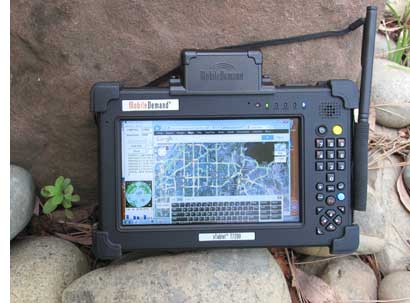 There are some compromises to running Windows 7 on a 1024 x 600 pixel resistive touch screen, but you get used to it and the device has all the functionality and features you'd expect in traditional Windows tablet. An integrated numeric keypad allows for rapid data entry, and there is an optional thumb-type keyboard. There are some compromises to running Windows 7 on a 1024 x 600 pixel resistive touch screen, but you get used to it and the device has all the functionality and features you'd expect in traditional Windows tablet. An integrated numeric keypad allows for rapid data entry, and there is an optional thumb-type keyboard.
The xTablet T7200 represents a substantial technology updated to the original xTablet T7000. A third generation dual-core Intel Atom N2600 processor with integrated graphics provides a very substantial performance increase over the predecessor model. In our benchmarks, the xTablet T7200 was about two and a half times as fast overall. If that is not enough, MobileDemand offers the unit with the even more powerful N2800 processor. Despite the extra performance, battery life is up to ten hours.
The wide-format 7-inch WSVGA resistive touchscreen display is bright and very sharp, but those used to tablets with active pens or dual-mode digitizers may miss the active digitizer (which MobileDemand offers as an option) or the effortless operation of capacitive touch. However, the touch screen is quick and precise. What's new is the availability of xView Pro, an innovative indoor-outdoor display technology that allows the display to remain clearly viewable even in direct sunlight. And it saves battery power as the technology lowers, rather than increases, the backlight outdoors.
The small xTablet T7200 does not have all the connectivity of full-size systems, but you still get a USB port, a LAN jack, and a serial port, and more via one of the optional docks. The device has an SDHC card slot and either a miniPCIe, PC Card or Smart Card slot. Among options are an integrated 5-megapixel camera with LED illuminator, an integrated 1D/2D imager, mobile broadband, and GPS.
In terms of ruggedness, the xTablet T7200 feels sturdy enough to withstand most abuse, and its thick rubber bumpers provide extra protection.
Offering exemplary performance, long battery life and impressive ruggedness, the xTablet T7200 represents a very attractive package for any application that requires full Windows in the field.
-- Conrad H. Blickenstorfer, September 2012
MobileDemand xTablet T7200 Specs:
| Type |
Compact rugged pen tablet
|
| Processor |
Dual-core 1.6GHz Intel Atom N2600 with 1MB L2 cache, or
Dual-core 1.8GHz Intel Atom N2800 with 1MB L2 cache
|
| Display Chipset |
Intel NM10 Express |
| OS |
Windows 7 Professional (32-bit) |
| Memory |
2GB DDR3 RAM, 800MHz |
| Display |
7" WSVGA (1024 x 600 pixel) TFT (xView Pro reflective/transflective sunlight-readable option available) |
| Digitizer |
Resistive touch screen (digitizer optional) |
| Keyboard |
Backlit 25-key numeric keypad with additional keys |
| Storage |
mSATA 32-128GB solid state disk |
| Expansion slots |
1 SDHC card slot plus either Mini PCIe with SIM OR PC Card Type II OR Smart Card |
| Housing |
Lightweight magnesium alloy chassis, plastic body, rubber bumpers |
| Size |
8.8" x 5.7" x 1.56" (w/o. rubber bumpers) |
| Weight |
3.25 pounds as tested (dual battery, bumpers, WWAN module) |
| Operating temperature |
-4° to 140° Fahrenheit (-20° to +60° Centigrade) |
| Ingress protection |
IP65; MIL-STD 810G, 506.5 Proc. I 4" per hour, 40psi for 10 minutes on all axes) |
| Drop/shock |
MIL-STD-801G, 516.4 IV: 26 repeated drops to one operating unit to plywood over concrete from five feet |
| Power |
Standard hi-capacity packs 7.2V/5,200mAH 37.44 watt-hour Li-Ion hot-swappable battery system ("8 to 12 hours, depending on screen type and use") |
| Interface |
Standard I/O module: 1 x USB 2.0, 1 x RS-232 serial; RJ45, Intermec EA11 2D imager, integrated 5mp camera w/ LED flash, surface mount dock |
| Wireless options |
Internal Intel Centrino Advanced-N 6235 802.11a/b/g/n with Bluetooth 4.0, optional integrated uBlox 6 GPS, optional GOBI 3000 WWAN (AT&T/T-Mobile or Verizon/Sprint) or 4G LTE (Verizon)
|
| Price |
Inquire |
| Contact |
MobileDemand www.ruggedtabletpc.com |
(copyright 2012 RuggedPCReview.com)
|
|
|
|




